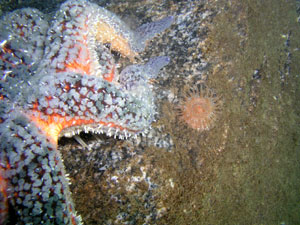Yankee Cove Artificial Reef Mitigation Project
Yankee Cove Artificial Reefs

Yankee Cove near Juneau, Alaska. Photo: Allan Culbreath, Alaska Department of Transportation
Two artificial reefs composed of granite boulders were constructed in December 2008 at Yankee Cove in Lynn Canal near Juneau, Alaska. The goal of the Yankee Cove reef project is to enhance habitat important to spawning and rearing fish including Pacific herring and marine invertebrates. Researchers from the University of Alaska Fairbanks and NOAA Fisheries will study colonization and development of the marine benthic community in this newly created habitat and make comparisons with natural reefs to determine the effectiveness of artificial reefs in northern waters.

Barge carrying granite boulders to build reef. Photo: Allan Culbreath, Alaska Department of Transportation
Funding was provided by the Alaska Department of Transportation and Public Facilities as partial mitigation for potential nearshore and subtidal habitat loss from future Juneau Access Project road construction along Lynn Canal.
The reefs are approximately 30 meters long, 10 meters wide, and 2 meters deep. They were installed at depths of five to eight meters. They are constructed of one to four layers of one-half to one meter diameter local quarry rock.
In temperate seas worldwide, artificial reefs provide structure for subtidal macroalgal communities and host fish populations in densities exceeding nearby natural reefs. Natural reefs in Southeast Alaska host dense and productive understory kelp forests, providing habitat for spawning Pacific herring, juvenile rockfish, red king crab, kelp greenling, gunnels, warbonnets, uchins, sea cucumbers, Dungeness crabs, and a myriad of other species, including several top predators, such as giant Pacific octopus and Steller sea lions.

Juvenile red king crab dwelling beneath understory kelp on a shallow subtidal reef near Yankee Cove. The artificial reefs were designed to include features beneficial to crab and other commercially important species. Photo: Jodi Pirtle
The Yankee Cove reefs were designed by graduate student Daniel Okamoto, and Dr. Ginny Eckert of the University of Alaska Fairbanks Juneau School of Ocean and Fisheries Sciences. Prior to reef construction, Okamoto conducted surveys of the construction site, adjacent natural reefs, and comparable natural reefs in the region. Nearby natural reefs serve as controls and are surveyed along with the constructed artificial reefs to measure fish and invertebrate use, and colonization of the bare rock by algae is measured along fixed transect lines and survey plots.
Within three months of the artificial reef installation, researchers observed colonization by kelps and red algae, anemones, seastars, hydroids, and fish. Plans are to monitor the reef for five years post installation in a collaboration between researchers from UAF and NOAA. Researchers anticipate that a highly productive reef community will develop, similar to that on adjacent natural reefs.

Daniel Okamoto surveying a permanently fixed plot for algae and invertebrates on the natural reference reef adjacent to the west artificial reef in March 2008. Photo: Bill Bechtol

Anemone next to a sunflower starfish on the new artificial reef. Photo: Daniel Okamoto
For more information contact:
- Daniel K. Okamoto, UAF graduate student, Project Lead
- Ginny L. Eckert, UAF Associate Professor
- Sue Walker, NMFS Marine Resources Specialist